Abstract
Humoral antibodies to tumour associated membrane antigens of cultured human breast cancer cell lines were studied using the immune adherence (IA) test. Sera from 353 post-operative breast cancer patients and from twenty-five patients immunized by allogeneic breast cancer cells were tested against the MDA-MB-436 cell line. Fifty-five (15.6%) sera samples from the non-vaccinated group and 131 (77.3%) of 168 sera samples from the immunotherapy group were IA-positive to this cell line after absorption with bovine erythrocytes to exclude antibody to heterologous membrane antigens (HM Ag). Forty-five of the 55 positive-sera from the non-immunized group and 113 of the 131 positive sera from the immunized group became IA-negative after further absorption with lymphoblastoid cells autologous to MDA-MB-436. Subsequently, the twenty-eight positive sera remaining sere tested for oncofetal antigens (OFA). After absorption with OFA rich tissues (fetal brain and M14 melanoma cells), no reactivity remained in the sera samples. In order to identify antibodies specific to breast cancer antigens, the 129 sera samples from non-immunized patients were tested against four other breast cancer cell lines; MDA-MB-157, MDA-MB-231, MCF-7 and UCLASO-B1. Four sera which reacted to more than three of the cell lines were identified. The reactivity of three of the four was due to anti-OFA antibody. The last serum sample was reactive to anti-HLA antibodies. These results indicate that sera of patients with breast cancer contain antibodies to OFA, but do not detect breast histologic type specific antigens as tested by IA using five breast cancer cultured cell lines.
Full text
PDF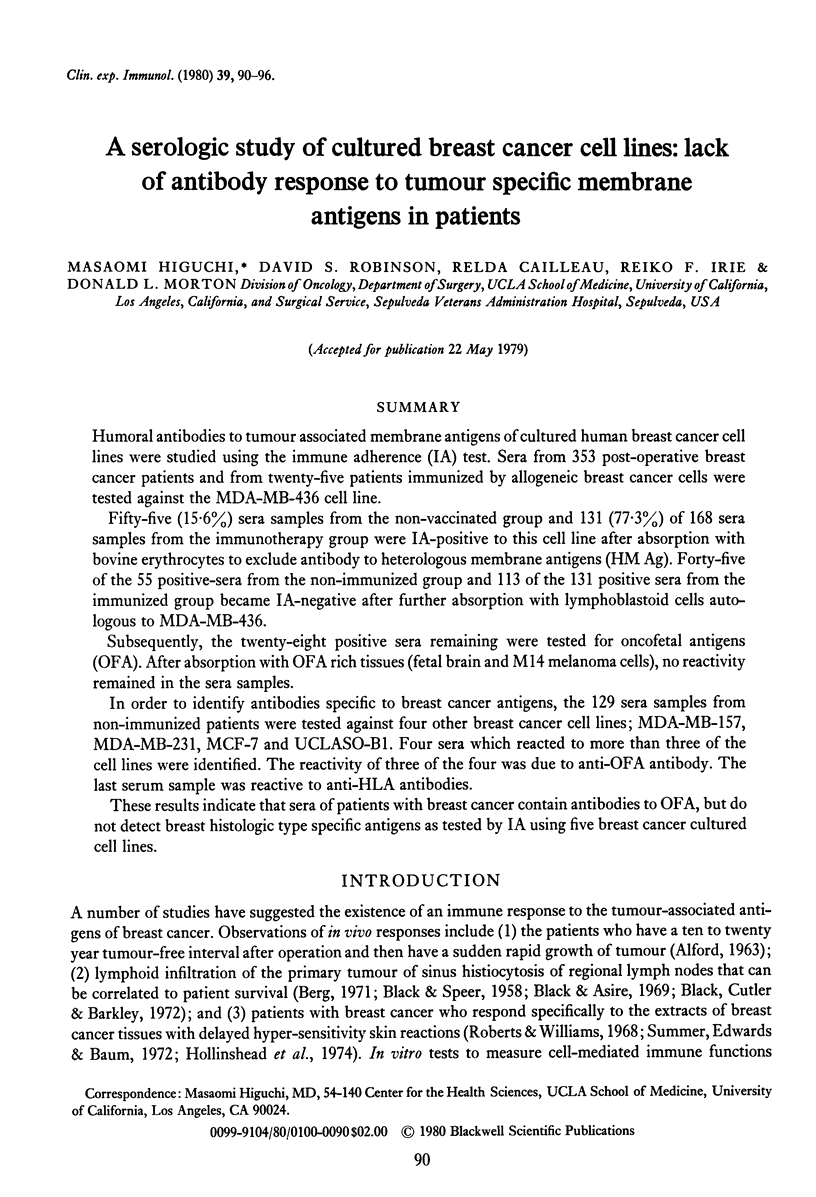
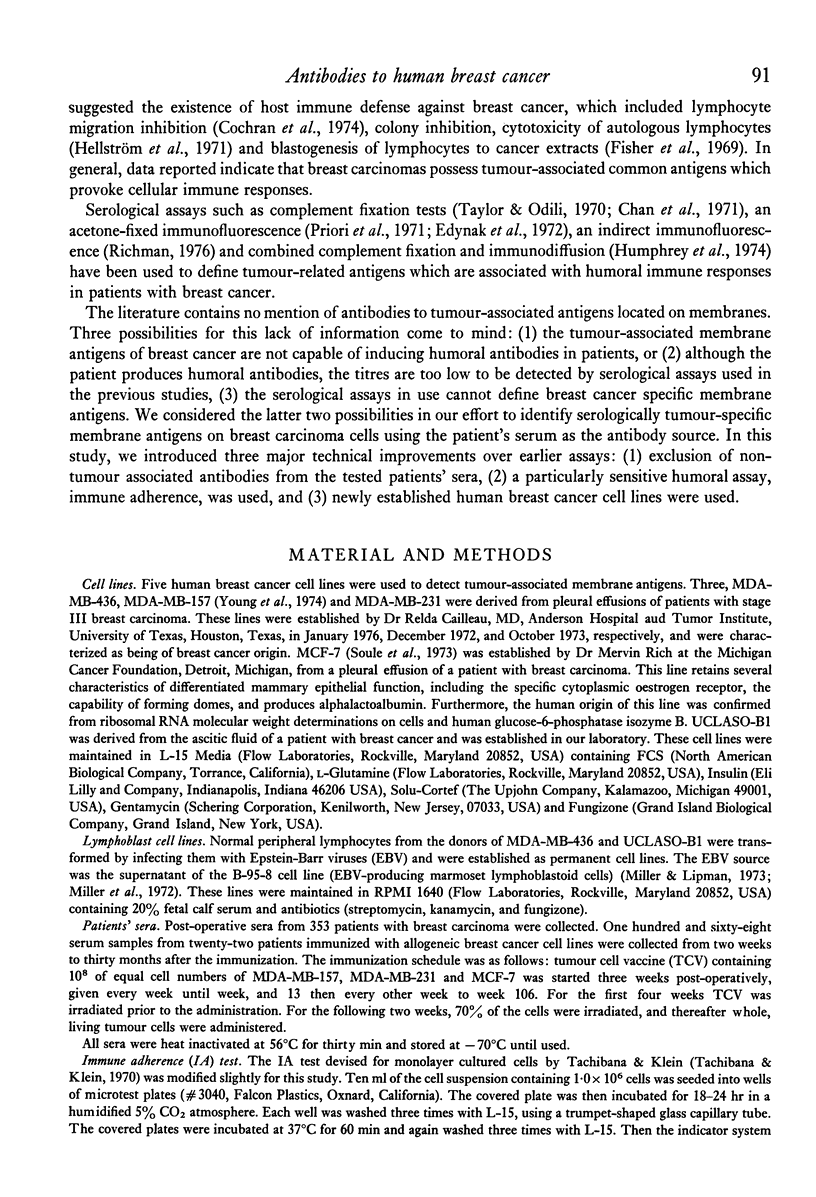
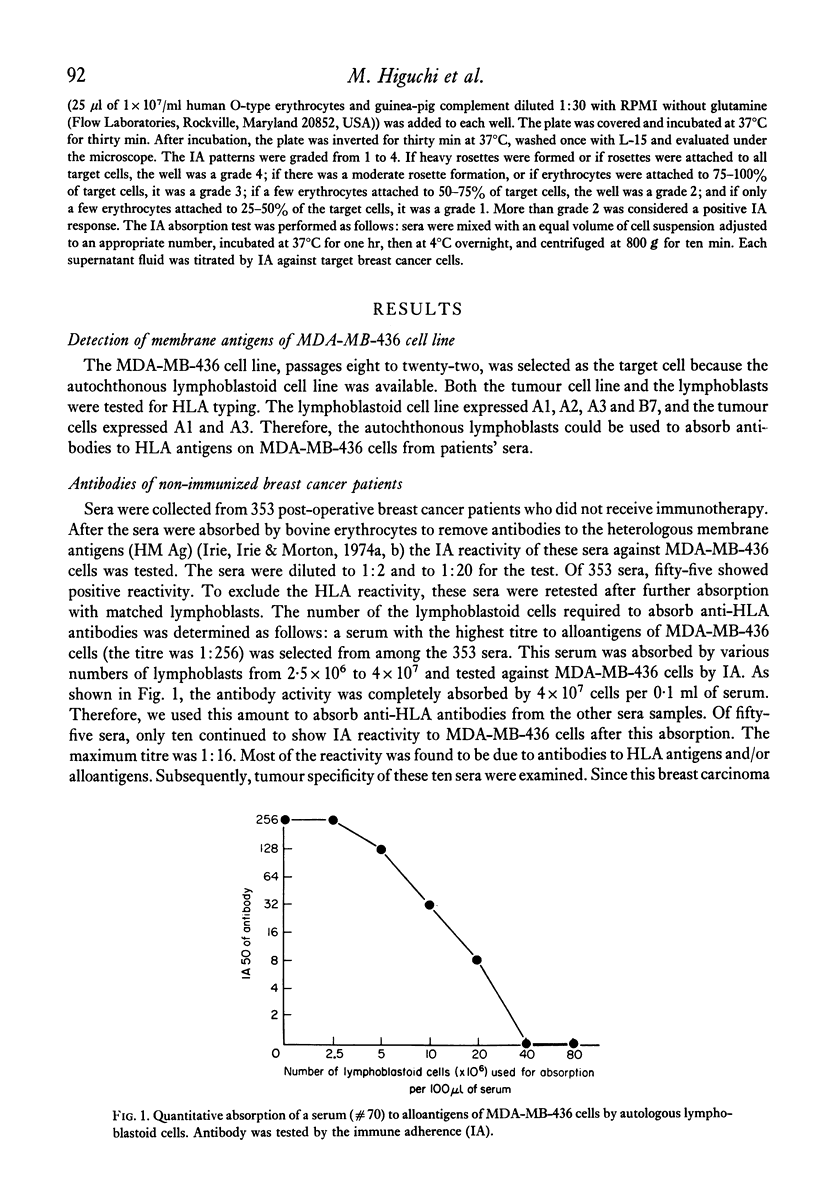
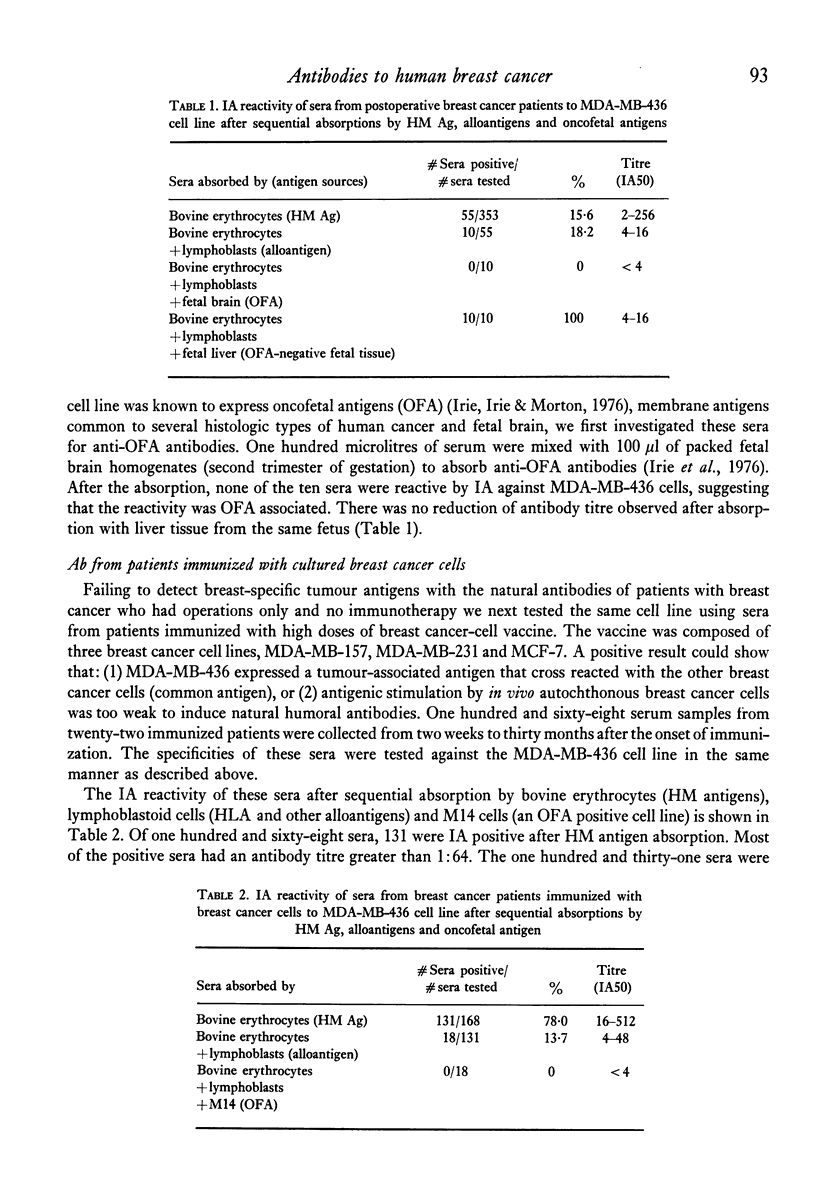
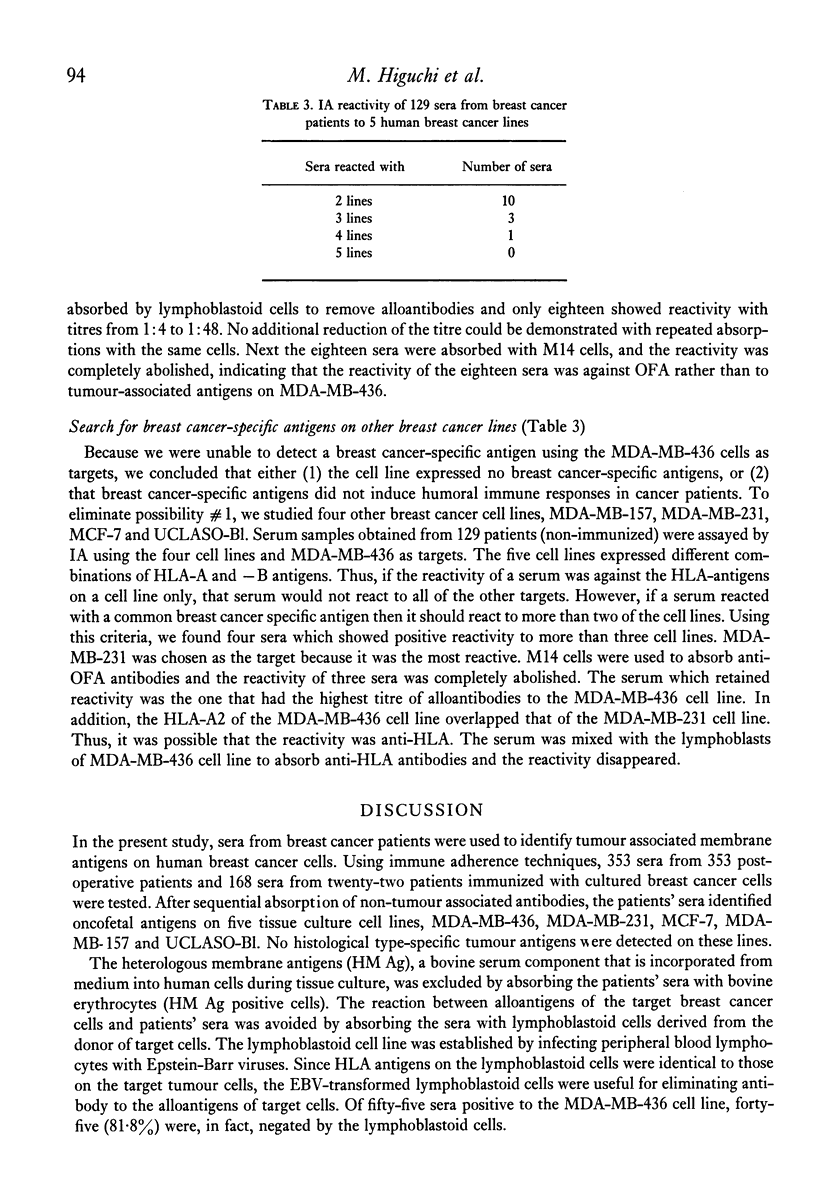
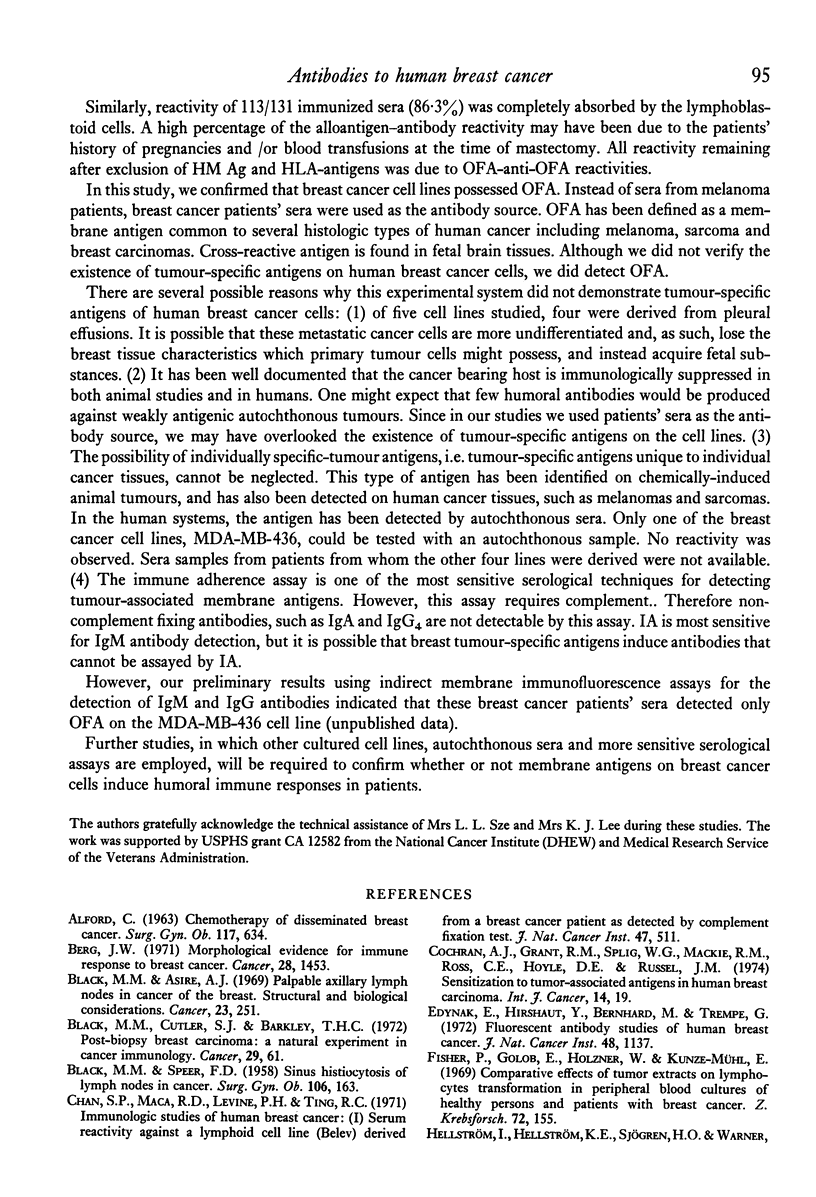
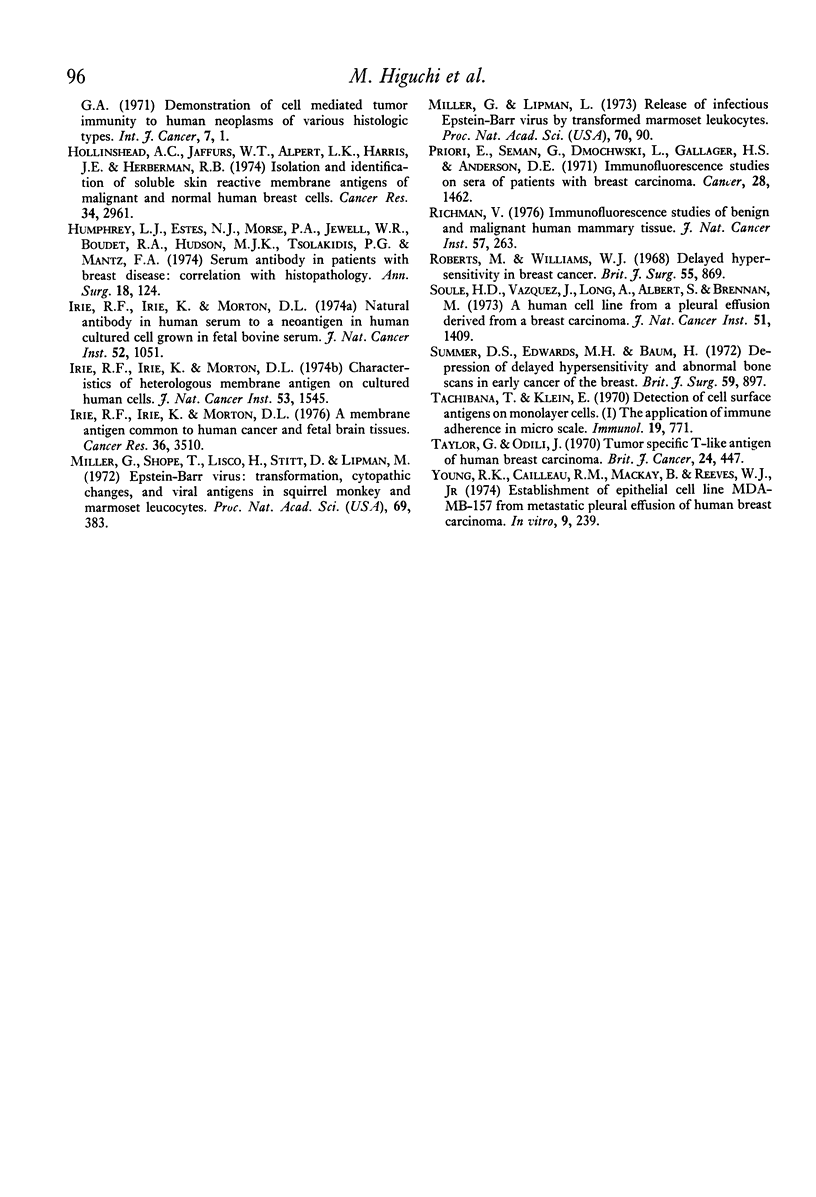
Selected References
These references are in PubMed. This may not be the complete list of references from this article.
- ALFORD T. C. CHEMOTHERAPY OF DISSEMINATED BREAST CANCER. Surg Gynecol Obstet. 1963 Nov;117:634–635. [PubMed] [Google Scholar]
- BLACK M. M., SPEER F. D. Sinus histiocytosis of lymph nodes in cancer. Surg Gynecol Obstet. 1958 Feb;106(2):163–175. [PubMed] [Google Scholar]
- Berg J. W. Morphological evidence for immune response to breast cancer. An historical review. Cancer. 1971 Dec;28(6):1453–1456. doi: 10.1002/1097-0142(197112)28:6<1453::aid-cncr2820280618>3.0.co;2-p. [DOI] [PubMed] [Google Scholar]
- Black M. M., Asire A. J. Palpable axillary lymph nodes in cancer of the breast. Structural and biologic considerations. Cancer. 1969 Feb;23(2):251–259. doi: 10.1002/1097-0142(196902)23:2<251::aid-cncr2820230202>3.0.co;2-b. [DOI] [PubMed] [Google Scholar]
- Black M. M., Cutler S. J., Barclay T. H. Post-biopsy breast carcinoma: a natural experiment in cancer immunology. Cancer. 1972 Jan;29(1):61–65. doi: 10.1002/1097-0142(197201)29:1<61::aid-cncr2820290111>3.0.co;2-7. [DOI] [PubMed] [Google Scholar]
- Chan S. P., Maca R. D., Levine P. H., Ting R. C. Immunologic studies of human breast cancer. I. Serum reactivity against a lymphoid cell line (Belev) derived from a breast cancer patient as detected by complement-fixation test. J Natl Cancer Inst. 1971 Sep;47(3):511–517. [PubMed] [Google Scholar]
- Cochran A. J., Grant R. M., Spilg W. G., Mackie R. M., Ross C. E., Hoyle D. E., Russell J. M. Sensitization to tumour-associated antigens in human breast carcinoma. Int J Cancer. 1974 Jul 15;14(1):19–25. doi: 10.1002/ijc.2910140103. [DOI] [PubMed] [Google Scholar]
- Edynak E. M., Hirshaut Y., Bernhard M., Trempe G. Fluorescent antibody studies of human breast cancer. J Natl Cancer Inst. 1972 Apr;48(4):1137–1143. [PubMed] [Google Scholar]
- Golob E., Fischer P., Holzner H., Kunze-Mühl E. Comparative effects of tumor extracts on lymphocyte transformation in peripheral blood cultures of healthy persons and patients with breast cancer. Z Krebsforsch. 1969;72(2):155–161. doi: 10.1007/BF00524771. [DOI] [PubMed] [Google Scholar]
- Hollinshead A. C., Jaffurs W. T., Alpert L. K., Harris J. E., Herberman R. B. Isolation and identification of soluble skin-reactive membrane antigens of malignant and normal human breast cells. Cancer Res. 1974 Nov;34(11):2961–2968. [PubMed] [Google Scholar]
- Irie R. F., Irie K., Morton D. L. A membrane antigen common to human cancer and fetal brain tissues. Cancer Res. 1976 Sep;36(9 Pt 2):3510–3517. [PubMed] [Google Scholar]
- Irie R. F., Irie K., Morton D. L. Characteristics of heterologous membrane antigen on cultured human cells. J Natl Cancer Inst. 1974 Dec;53(6):1545–1551. [PubMed] [Google Scholar]
- Irie R. F., Irie K., Morton D. L. Natural antibody in human serum to a neoantigen in human cultured cells grown in fetal bovine serum. J Natl Cancer Inst. 1974 Apr;52(4):1051–1058. doi: 10.1093/jnci/52.4.1051. [DOI] [PubMed] [Google Scholar]
- Miller G., Shope T., Lisco H., Stitt D., Lipman M. Epstein-Barr virus: transformation, cytopathic changes, and viral antigens in squirrel monkey and marmoset leukocytes. Proc Natl Acad Sci U S A. 1972 Feb;69(2):383–387. doi: 10.1073/pnas.69.2.383. [DOI] [PMC free article] [PubMed] [Google Scholar]
- Priori E. S., Seman G., Dmochowski L., Gallager H. S., Anderson D. E. Immunofluorescence studies on sera of patients with breast carcinoma. Cancer. 1971 Dec;28(6):1462–1471. doi: 10.1002/1097-0142(197112)28:6<1462::aid-cncr2820280620>3.0.co;2-d. [DOI] [PubMed] [Google Scholar]
- Richman A. V. Immunofluorescence studies of benign and malignant human mammary tissue. J Natl Cancer Inst. 1976 Aug;57(2):263–267. doi: 10.1093/jnci/57.2.263. [DOI] [PubMed] [Google Scholar]
- Roberts M. M., Williams W. J. Delayed hypersensitivity in breast cancer. Br J Surg. 1968 Nov;55(11):869–869. [PubMed] [Google Scholar]
- Soule H. D., Vazguez J., Long A., Albert S., Brennan M. A human cell line from a pleural effusion derived from a breast carcinoma. J Natl Cancer Inst. 1973 Nov;51(5):1409–1416. doi: 10.1093/jnci/51.5.1409. [DOI] [PubMed] [Google Scholar]
- Sumner D. S., Edwards M. H., Baum M. Depression of delayed hypersensitivity and abnormal bone scans in early cancer of the breast. Br J Surg. 1972 Nov;59(11):897–897. [PubMed] [Google Scholar]
- Tachibana T., Klein E. Detection of cell surface antigens on monolayer cells. I. The application of immune adherence on a micro scale. Immunology. 1970 Nov;19(5):771–782. [PMC free article] [PubMed] [Google Scholar]
- Taylor G., Odili J. L. Tumour specific T-like antigen of human breast carcinoma. Br J Cancer. 1970 Sep;24(3):447–453. doi: 10.1038/bjc.1970.53. [DOI] [PMC free article] [PubMed] [Google Scholar]


